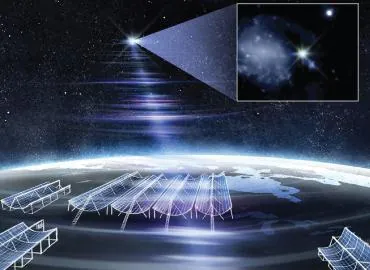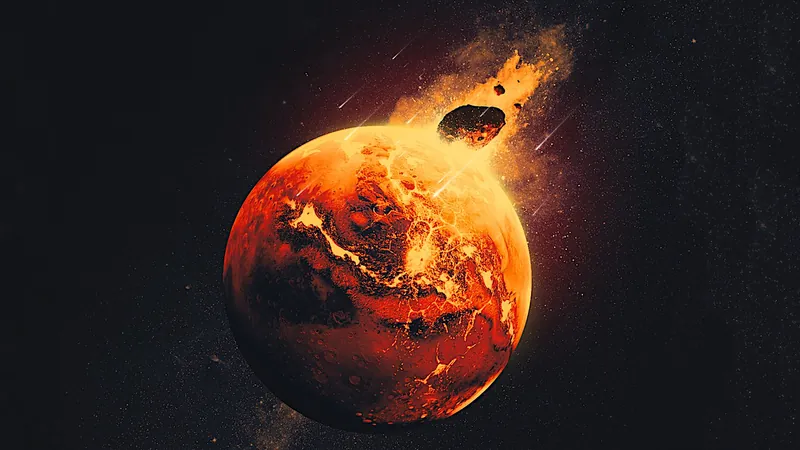
Astronomers Discover the Brightest Fast Radio Burst Yet—Here’s What They Found!
2025-08-25
Author: Michael
A Breakthrough in Astronomy: The Brightest Fast Radio Burst Ever Recorded
An international team of astronomers, featuring experts from the University of Toronto, has achieved a groundbreaking milestone by detecting the brightest Fast Radio Burst (FRB) ever observed. This incredible discovery has allowed scientists to not only record the event but also determine its precise location within a neighboring galaxy, propelling us into a new era of cosmic exploration!
What Are Fast Radio Bursts?
Fast Radio Bursts are powerful bursts of radio waves originating from distant parts of the universe, shrouded in mystery and complexity. These brief, intense signals are linked to extreme astrophysical phenomena that remain largely unclear to researchers. Since its launch in 2018, the Canadian Hydrogen-Intensity Mapping Experiment (CHIME) has captured thousands of FRBs, yet tracing their origins has been a difficult challenge.
Meet RBFLOAT: The Radio Brightest Flash of All Time!
Dubbed FRB 20250316A, or RBFLOAT, this extraordinary signal was detected using the new CHIME/FRB Outrigger array—essentially advanced mini-telescopes located in British Columbia, Northern California, and West Virginia. This innovative setup allowed astronomers to utilize Very Long Baseline Interferometry (VLBI) techniques, providing unmatched accuracy in pinpointing the FRB's location.
Luckily for the team, the timing of their observations was crucial. "We were incredibly fortunate to pinpoint the FRB's exact sky position during our observations, especially since we faced a power outage right afterward that could have derailed our efforts," shared Mattias Lazda, a doctoral student at the University of Toronto.
A Cosmic Neighbor: Framing the Discovery!
FRBs like RBFLOAT are known to be some of the most powerful radio sources, but they last for only fractions of a second—briefly outshining all other radio emissions around them. Discovered on March 16, 2025, RBFLOAT lasted only about a fifth of a second, yet its brilliance and nearby origins—situated roughly 130 million light-years away in the outskirts of the galaxy NGC 4141—have made it a sensational subject for research.
Peering Deeper: The James Webb Space Telescope Joins the Hunt!
The remarkable brightness of RBFLOAT is attributed to its proximity. The source resides within a surprisingly compact area of only 45 light-years, allowing for unprecedented spatial resolution—the equivalent of spotting a guitar pick from 1,000 kilometers away! Astronomers swiftly leveraged this discovery, immediately analyzing data in a collaborative Zoom meeting.
The team followed up with observations from the James Webb Space Telescope (JWST), leading to the detection of a faint infrared signal at the burst’s location. This unexpected finding has sparked debates about whether the signal is linked to a red giant star or perhaps a lingering light echo from the FRB itself.
A Game Changer in FRB Research!
The data provided by the CHIME/FRB Outrigger array has opened a gateway to a deeper investigation of FRBs. As Peter Blanchard from Harvard notes, the JWST’s high-resolution capabilities allow astronomers to examine individual stars surrounding an FRB for the first time, crucial for understanding the stellar environments responsible for these cosmic bursts.
The Mystery Continues: Why Doesn't RBFLOAT Repeat?
Curiously, despite being the brightest FRB recorded by CHIME, RBFLOAT has not emitted repeat bursts, defying the common belief that most FRBs are cyclical. "This suggests that not all FRBs are repeaters, challenging existing theories and opening the door to explore more explosive origins for some of these enigmatic events," Amanda Cook, a Banting Postdoctoral Researcher, explained.
New Insights Await: Unraveling the Mysteries of the Universe!
Two studies detailing this astonishing phenomenon were published in the Astrophysical Journal Letters, one focusing on the original radio discovery and the other on the JWST’s near-infrared imagery. These findings not only enhance our understanding of FRBs but also position them as tools to probe deeper into the cosmic unknown!









 Brasil (PT)
Brasil (PT)
 Canada (EN)
Canada (EN)
 Chile (ES)
Chile (ES)
 Česko (CS)
Česko (CS)
 대한민국 (KO)
대한민국 (KO)
 España (ES)
España (ES)
 France (FR)
France (FR)
 Hong Kong (EN)
Hong Kong (EN)
 Italia (IT)
Italia (IT)
 日本 (JA)
日本 (JA)
 Magyarország (HU)
Magyarország (HU)
 Norge (NO)
Norge (NO)
 Polska (PL)
Polska (PL)
 Schweiz (DE)
Schweiz (DE)
 Singapore (EN)
Singapore (EN)
 Sverige (SV)
Sverige (SV)
 Suomi (FI)
Suomi (FI)
 Türkiye (TR)
Türkiye (TR)
 الإمارات العربية المتحدة (AR)
الإمارات العربية المتحدة (AR)